99+ Powerful ChatGPT Prompts for Data Analysis to Boost Your Insights
Would you like to elevate your data analysis game effortlessly? Unlock the potential of Powerful ChatGPT Prompts for Data Analysis. Custom-built for precision, these powerful chatgpt prompts guide the AI to generate insightful responses, making complex data analysis a breeze. Harness the efficiency of ChatGPT to streamline your analytical processes and unlock new dimensions in information extraction.
You’ve probably felt stuck while analyzing data, unsure of how to get started or what to do? Data analysis, with its complex layers, beckons curious minds to discover its hidden insights. The challenge presents a unique opportunity to learn and grow together. With ChatGPT Prompts for data analysis, bid farewell to the confusion. Effortlessly guides the AI to unravel the complexities, turning data analysis into a seamless journey of discovery and understanding.
Embark on a journey where ChatGPT Prompts for data analysis become your guiding light. No more wrestling with complex data; instead, effortlessly unravel insights. Readers, anticipate a transformative experience as you explore this article. Unlock the power to simplify data analysis, turning challenges into victories with ChatGPT Prompts.
How ChatGPT Prompts for Data Analysis Simplify Analysis
In the fast-paced world of AI, precision is paramount. Leveraging these prompts guarantees crystal-clear communication, avoiding miscommunications that could impact professional reputation. For busy professionals deeply involved in the AI landscape, these pre-built prompts serve as a time-saving solution, providing efficiency, clarity, and simplicity in crafting optimized messages. They empower individuals to navigate the complexities of data analysis effortlessly.
How will ChatGPT Prompts for data analysis benefit you? Mastering data analysis is akin to having a superpower for professionals. These prompts transform how one navigates and understands data complexities, serving as a reliable compass for accurate decision-making. Whether managing business finances or personal budgets, these prompts bring efficiency, clarity, and simplicity to the data analysis journey. In the realm of performance evaluations, custom-built ChatGPT prompts streamline the process, saving valuable time and boosting overall productivity, resulting in insightful roadmaps for project excellence.
How to Use ChatGPT Prompts for Data Analysis?
For Master prompt, just copy prompt, open a new chat in chatgpt and paste it there. Model will start asking questions about your requirements. Model will ask questions one by one and you have to answer with your requirements. Hence the model will collect all your specific requirements. Model will get all the requirements so that it can produce the customized response specifically for you. Also, you can share feedback at every step. Model is set in the way that it will take feedback from you at every step and work as per your constructive feedback so be very honest while sharing feedback.
For Other Prompts, some prompts have spaces [Input Your Data] like this. You are supposed to add your specific data according to your requirements. These spaces have been included so that you get customized responses and not the general one. So, Copy the prompt, fill the input fields, paste it in a new chat in chatgpt.
Some prompts are for general use. They come pre-formatted for seamless integration. Copy and then paste them in a new chat in chatgpt if you need them.
We are sharing a list of 99+ Prompts so select according to your choice and use them.
Use ChatGPT’s Premier Prompt for Data Analysis for Advanced Insights and Analytics
Act as a professional data analyst. You have analyzed the whole data provided by me.Here is my data[input data]. Ask me all necessary questions to analyze my data properly according to my requirements. Begin by asking the objective and purpose of data analysis.Then confirm the type of data analysis (Descriptive, Diagnostic, Predictive, prescriptive) . I want you to analyze data according to the type of data I ask you to do even if it is out of these types.
Then proceed by asking the key points I mainly want to extract and uncover. If I am unsure about the key points I require then Perform a comprehensive data analysis on the provided dataset to uncover meaningful insights and trends by keeping in mind the purpose and objective of my data analysis.Then extract the comprehensive and actionable data about the key points that are confirmed by me.
Get clear understanding of word limitation from me for delivering the best possible output.
Utilize appropriate statistical methods, and data cleaning procedures to interpret the information effectively. Your goal is to derive actionable conclusions and recommendations based on the data. Feel free to use programming languages, statistical tools, or any other relevant techniques to ensure a thorough analysis. Consider the specific objectives and context of the analysis, keeping in mind the intended audience and the decision-making implications of your findings. Please document your analysis process, including the steps taken and the rationale behind your choices, to provide a clear and transparent overview of my approach.
Proceed step wise after my confirmation and feedback at each step, please don’t extract the whole data at once. Only add my required data and key points I ask you to add and don’t go beyond the limits and my requirements.
4 Helpful ChatGPT Prompts for Mastering Data Analysis
Descriptive Statistics for a Dataset
[Input Data:Provide a dataset with relevant variables]Calculate and present the descriptive statistics (mean, median, mode, range, standard deviation, etc.) for the given dataset.
Correlation Analysis
[Input Data: Provide two or more variables for correlation analysis]Determine the correlation coefficient between the specified variables and interpret the strength and direction of the relationship.
Time Series Analysis
[Input Data:Provide a time series dataset with timestamps]Conduct time series analysis on the given data, including trend analysis, seasonality detection, and any patterns or anomalies.
Hypothesis Testing
[Input Data:Provide two datasets for comparison] Formulate a hypothesis, choose an appropriate statistical test, and perform hypothesis testing to determine if there is a significant difference between the two datasets. Include relevant p-values and confidence intervals.
Top 99 ChatGPT Prompts for Data Analysis for Excellence
- Descriptive Statistics for a Dataset
[Input: Provide a dataset with relevant variables] Calculate and present the descriptive statistics (mean, median, mode, range, standard deviation, etc.) for the given dataset.
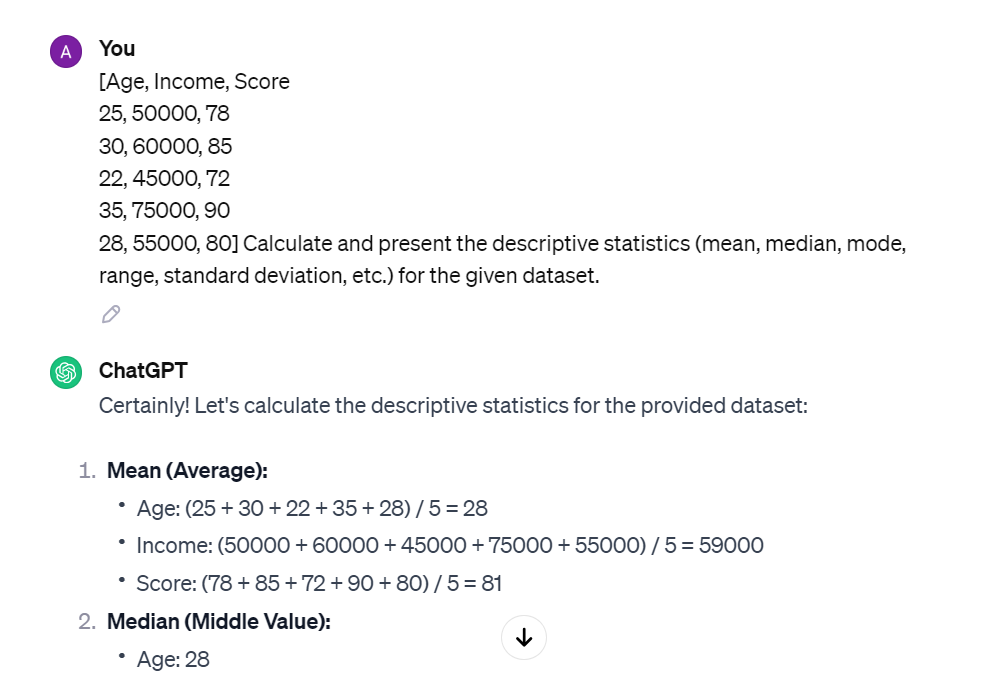
- Cluster Analysis
[Input: Provide a dataset with multiple variables] Apply cluster analysis techniques (e.g., k-means clustering) to identify natural groupings within the dataset. Present the results and discuss the characteristics of each cluster.
- Correlation Analysis
[Input: Provide two or more variables for correlation analysis] Determine the correlation coefficient between the specified variables and interpret the strength and direction of the relationship.
- Time Series Analysis
[Input: Provide a time series dataset with timestamps] Conduct time series analysis on the given data, including trend analysis, seasonality detection, and any patterns or anomalies.
- Regression Analysis
[Input: Provide two correlated variables for regression analysis] Perform linear regression analysis on the provided data to model the relationship between the variables. Interpret the coefficients and assess the goodness of fit of the regression model.
- Anomaly Detection
[Input: Provide a dataset with a time component] Utilize anomaly detection methods to identify unusual patterns or outliers in the given time-series data. Discuss the potential reasons behind the detected anomalies.
- Factor Analysis
[Input: Provide a dataset with multiple observed variables] Conduct factor analysis to identify latent factors influencing the observed variables. Interpret the factor loadings and explain the underlying structure.
- Geographic Spatial Analysis
[Input: Provide a dataset with geographical coordinates] Perform spatial analysis to identify patterns or trends based on geographic locations. Visualize the data on a map and draw insights from the spatial distribution.
- Customer Segmentation
[Input: Provide customer-related data] Use segmentation techniques to group customers based on their behavior, demographics, or other relevant factors. Analyze each segment’s characteristics.
- Network Analysis
[Input: Provide data representing a network or relationships between entities] Analyze the network structure, identify central nodes, and explore the relationships between entities. Evaluate network properties and connectivity.
- A/B Testing
[Input: Provide data from an A/B test] Analyze the results of an A/B test, including statistical significance, confidence intervals, and practical significance. Draw conclusions about the effectiveness of the tested changes.
- Survival Analysis
[Input: Provide data with time-to-event information] Conduct survival analysis to model time until a specific event occurs. Estimate survival curves and identify factors influencing the survival outcome.
- Market Basket Analysis
[Input: Provide transactional data, e.g., from a retail store] Analyze the associations between items purchased together. Identify frequent itemsets and association rules to understand customer buying patterns.
- Sensitivity Analysis
[Input: Provide data with varying parameters] Perform sensitivity analysis to assess the impact of changes in input parameters on the output. Identify key factors influencing the results.
- Principal Component Analysis (PCA)
[Input: Provide a dataset with multiple variables] Apply PCA to reduce dimensionality and identify principal components. Interpret the variance explained by each principal component.
- Time-Depth Analysis
[Input: Provide time-series data with depth information] Explore how data patterns change over time and depth. Analyze trends and variations in the dataset, considering both temporal and spatial dimensions.
- Sentiment Analysis on Social Media Data
[Input: Provide a dataset of social media posts or comments] Analyze sentiment in the provided social media data. Determine the overall sentiment and identify any patterns or topics driving sentiment.
- Cohort Analysis
[Input: Provide data with a time component and user cohorts] Conduct cohort analysis to track the behavior of specific user cohorts over time. Examine retention, conversion, or other relevant metrics.
- Equity Portfolio Analysis
[Input: Provide historical stock prices and related financial data] Analyze the performance of an equity portfolio, including risk and return metrics. Evaluate the impact of diversification on the overall portfolio.
- Predictive Modeling for Public Health Outcomes
[Input: Provide public health data] Develop predictive models to anticipate public health outcomes. Analyze epidemiological data to predict disease trends and inform preventive measures.
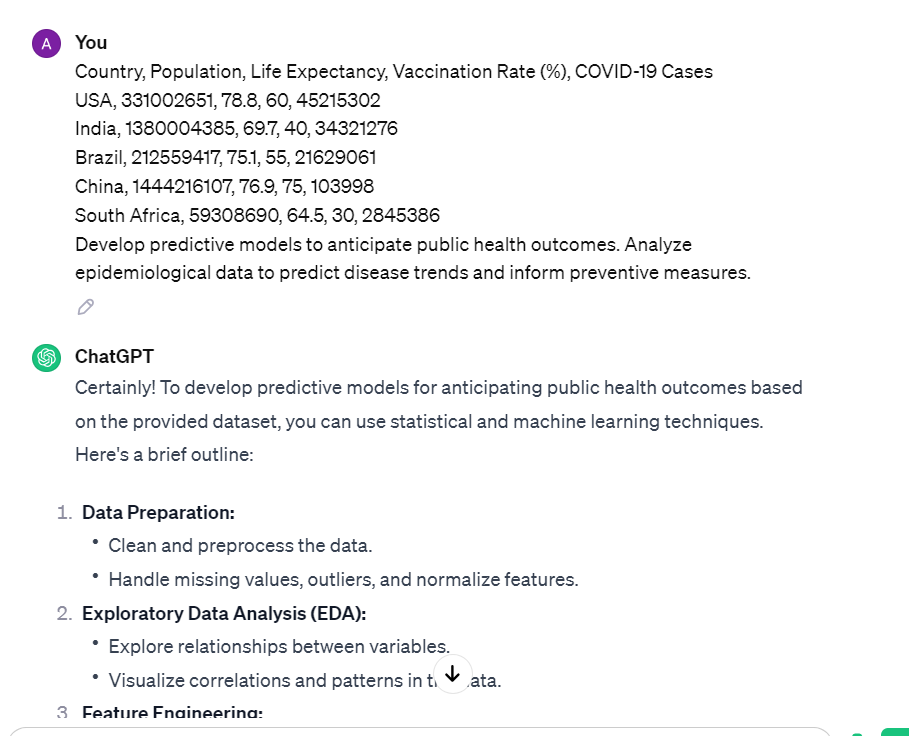
- Textual Data Clustering
[Input: Provide a dataset with text data]
Apply clustering algorithms to group similar text documents. Explore patterns and themes within each cluster to gain insights into the underlying structure of the textual data.
- Time-Weighted Return Calculation
[Input: Provide historical financial data]
Calculate the time-weighted return for a portfolio or investment over a specified period. Consider factors such as cash flows and market valuations in the performance calculation.
- Social Network Influence Analysis
[Input: Provide social network data]
Analyze the influence of individuals within a social network. Identify key influencers, measure centrality, and explore the impact of network structure on information flow.
- Fraud Detection in Financial Transactions
[Input: Provide transactional data]
Implement fraud detection algorithms to identify potentially fraudulent financial transactions. Examine anomalies and patterns indicative of fraudulent behavior.
- Topic Modeling on Documents
[Input: Provide a collection of documents]
Apply topic modeling techniques, such as Latent Dirichlet Allocation (LDA), to uncover latent topics within a corpus of documents. Analyze the distribution of topics across the dataset.
- Demand Forecasting
[Input: Provide sales or demand data]
Utilize time series analysis and forecasting methods to predict future demand for products or services. Evaluate the accuracy of the forecasting model.
- Healthcare Patient Segmentation
[Input: Provide healthcare-related data]
Segment healthcare patients based on demographic and health-related attributes. Analyze each segment to tailor healthcare services and improve patient outcomes.
- Web User Behavior Analysis
[Input: Provide web analytics data]
Analyze user behavior on a website, including page views, click-through rates, and session durations. Identify patterns and optimize the user experience.
- Churn Prediction in Subscription Services
[Input: Provide customer subscription data]
Develop a model to predict customer churn in subscription-based services. Identify factors influencing customer retention and propose strategies to reduce churn.
- Spatial-Temporal Traffic Analysis
[Input: Provide traffic data with spatial and temporal information]
Analyze traffic patterns considering both spatial and temporal dimensions. Identify peak traffic times, congestion hotspots, and patterns in movement.
- Economic Impact Analysis
[Input: Provide economic indicators and related data]
Conduct an economic impact analysis to understand the effects of specific events or policies on economic variables. Evaluate the overall impact on employment, income, and other factors.
- Credit Risk Assessment
[Input: Provide credit application data]
Develop a credit risk assessment model to evaluate the creditworthiness of applicants. Consider variables such as credit history, income, and debt levels.
- Supply Chain Optimization
[Input: Provide supply chain data]
Optimize the supply chain by analyzing data related to inventory levels, production schedules, and delivery times. Identify opportunities for efficiency improvements.
- Natural Language Processing for Customer Feedback
[Input: Provide customer feedback data]
Apply natural language processing techniques to analyze customer feedback. Extract sentiment, identify common issues, and propose improvements based on feedback analysis.
- Employee Productivity Analysis
[Input: Provide employee performance data]
Analyze employee productivity metrics to identify factors influencing performance. Explore correlations between employee engagement, training, and overall productivity.
- Political Sentiment Analysis
[Input: Provide political discourse data]
Conduct sentiment analysis on political discourse to understand public sentiment towards political figures, policies, or events. Explore trends and polarization in opinions.
- Supply-Demand Imbalance Analysis
[Input: Provide supply and demand data]
Analyze supply and demand dynamics to identify imbalances in markets. Explore the impact on pricing, inventory levels, and potential strategies for balance.
- Energy Consumption Pattern Analysis
[Input: Provide energy consumption data]
Examine patterns in energy consumption data to identify peak usage times, trends, and potential areas for energy efficiency improvements.
- Online Retail Customer Journey Analysis
[Input: Provide online retail transaction data]
Analyze the customer journey in online retail, from browsing to purchase. Identify touchpoints, optimize conversion paths, and enhance the overall online shopping experience.
- Political Campaign Strategy Optimization
[Input: Provide political campaign data]
Optimize political campaign strategies by analyzing voter demographics, sentiment, and engagement data. Identify effective communication channels and messaging strategies.
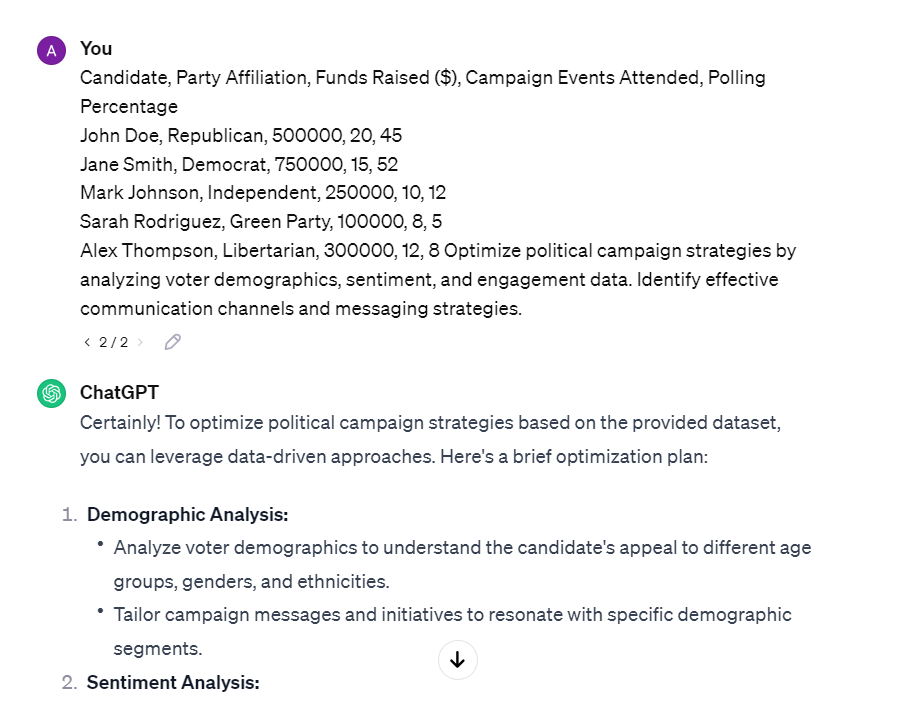
- Predictive Maintenance for Industrial Equipment
[Input: Provide equipment sensor data]
Implement predictive maintenance algorithms to forecast when industrial equipment might fail. Improve efficiency by scheduling maintenance activities before critical issues arise.
- E-commerce Customer Segmentation
[Input: Provide e-commerce transaction data]
Segment e-commerce customers based on their purchasing behavior, demographics, and preferences. Tailor marketing strategies to enhance customer engagement and retention.
- Sentiment Analysis on Product Reviews
[Input: Provide product review data]
Conduct sentiment analysis on product reviews to gauge customer satisfaction. Identify common sentiments, key features, and areas for product improvement.
- Human Resources Employee Turnover Prediction
[Input: Provide HR and employee data]
Develop a model to predict employee turnover within an organization. Identify factors contributing to turnover and propose retention strategies.
- Speech Emotion Recognition
[Input: Provide audio data with spoken content]
Implement speech emotion recognition algorithms to identify emotions conveyed in spoken content. Explore applications in customer service and human-computer interaction.
- Smart City Traffic Flow Optimization
[Input: Provide urban traffic data]
Optimize traffic flow in a smart city by analyzing real-time traffic data. Implement adaptive traffic signal control strategies to reduce congestion.
- Financial Fraud Detection in Credit Card Transactions
[Input: Provide credit card transaction data]
Deploy machine learning models to detect fraudulent credit card transactions. Enhance security measures and protect customers from unauthorized activities.
- Movie Recommendation System
[Input: Provide user movie ratings and preferences]
Develop a movie recommendation system based on collaborative filtering or content-based methods. Enhance user experience by suggesting relevant movies.
- Predicting Stock Price Movements
[Input: Provide historical stock price and market data]
Build predictive models to forecast stock price movements. Analyze technical and fundamental indicators to inform investment decisions.
- Web Scraping and Data Extraction
[Input: Specify target websites]
Implement web scraping techniques to extract data from specific websites. Automate data extraction processes for information retrieval and analysis.
- Healthcare Resource Allocation
[Input: Provide healthcare facility and patient data]
Optimize resource allocation in healthcare facilities by analyzing patient admission patterns, bed occupancy rates, and resource utilization.
- Predicting Housing Market Trends
[Input: Provide real estate transaction and housing data]
Develop models to predict housing market trends. Analyze factors such as location, economic indicators, and demographic changes.
- Customer Lifetime Value Prediction
[Input: Provide customer transaction and engagement data]
Calculate and predict customer lifetime value based on historical transaction data. Inform marketing strategies for customer acquisition and retention.
- Climate Change Impact Assessment
[Input: Provide climate and environmental data]
Conduct an impact assessment of climate change on various environmental factors. Analyze trends, identify hotspots, and propose mitigation strategies.
- Event Attendance Prediction
[Input: Provide event registration and attendee data]
Predict event attendance based on historical data and marketing efforts. Optimize event planning and resource allocation for improved attendance.
- Predicting Disease Outbreaks
[Input: Provide disease surveillance and epidemiological data]
Develop models to predict and monitor disease outbreaks. Analyze data to identify potential risk factors and patterns.
- Network Intrusion Detection
[Input: Provide network traffic and security data]
Implement intrusion detection systems to identify and respond to suspicious activities in computer networks. Enhance cybersecurity measures.
- Automated Social Media Posting Schedule
[Input: Provide social media engagement data]
Analyze social media engagement patterns to determine optimal posting schedules. Automate social media posting for maximum reach and impact.
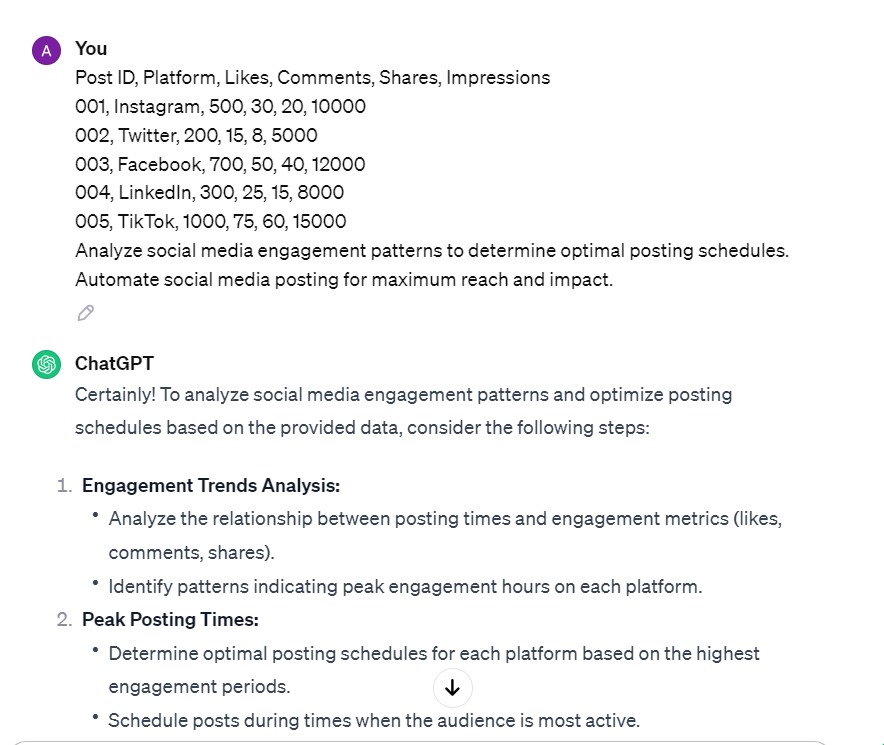
- Retail Shelf Space Optimization
[Input: Provide retail store layout and sales data]
Optimize retail shelf space by analyzing sales data and customer behavior. Improve product placement for increased visibility and sales.
- Election Outcome Prediction
[Input: Provide election-related data]
Develop models to predict election outcomes based on polling data, demographics, and historical trends. Inform campaign strategies and resource allocation.
61. Predictive Analytics for Customer Churn
[Input: Provide customer interaction and engagement data]
Use predictive analytics to identify potential customer churn. Analyze customer behavior and implement strategies to retain high-risk customers.
62. Energy Consumption Forecasting
[Input: Provide historical energy consumption data]
Develop models to forecast energy consumption patterns. Explore seasonal variations and factors affecting energy demand for better resource planning.
63. Social Media Influence Measurement
[Input: Provide social media engagement and interaction data]
Measure social media influence by analyzing engagement metrics, followers, and content interactions. Identify influencers and assess the impact of social media campaigns.
64. Healthcare Fraud Detection
[Input: Provide healthcare billing and claims data]
Implement fraud detection algorithms in healthcare billing systems. Identify irregularities in claims and billing practices to prevent fraudulent activities.
65. Automated Email Campaign Optimization
[Input: Provide email marketing campaign data]
Optimize email marketing campaigns using automated analysis. Evaluate open rates, click-through rates, and engagement metrics to enhance email marketing effectiveness.
66. Quality Control in Manufacturing
[Input: Provide manufacturing process data]
Implement quality control measures in manufacturing processes. Analyze production data to identify defects, improve quality, and optimize manufacturing efficiency.
67. Social Network Analysis for Influencer Marketing
[Input: Provide social network connections and engagement data]
Conduct social network analysis to identify potential influencers for marketing collaborations. Evaluate network structures and influencer impact.
68. Online Learning Platform User Engagement
[Input: Provide user interaction and learning data]
Analyze user engagement on online learning platforms. Identify patterns, assess course effectiveness, and improve user experience to enhance learning outcomes.
69. Human Resources Diversity and Inclusion Metrics
[Input: Provide HR data with diversity and inclusion indicators]
Analyze diversity and inclusion metrics within an organization. Evaluate workforce demographics, assess inclusion efforts, and identify areas for improvement.
70. Weather Impact on Retail Sales
[Input: Provide retail sales and weather data]
Explore the impact of weather on retail sales. Analyze sales patterns in relation to weather conditions to optimize inventory and marketing strategies.
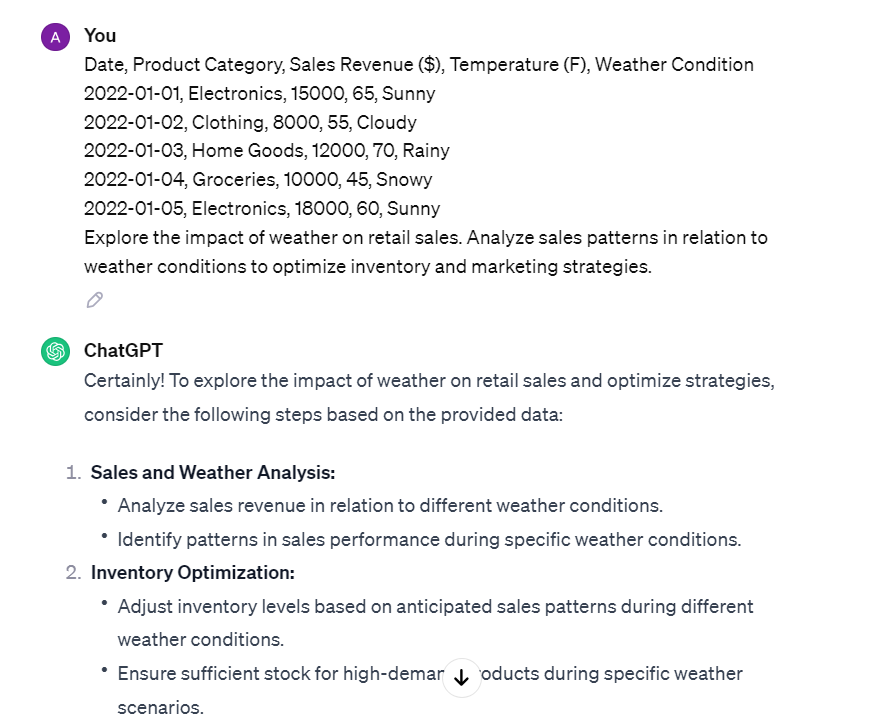
71. Predictive Maintenance for Vehicles
[Input: Provide vehicle sensor and maintenance data]
Implement predictive maintenance for vehicles using sensor data. Predict maintenance needs to reduce downtime and improve vehicle reliability.
72. E-commerce Fraud Detection
[Input: Provide e-commerce transaction and user data]
Develop models for detecting fraud in e-commerce transactions. Analyze user behavior and transaction patterns to identify and prevent fraudulent activities.
73. Smart Home Device Usage Analysis
[Input: Provide smart home device interaction data]
Analyze usage patterns of smart home devices. Identify user preferences, optimize device functionalities, and enhance the overall smart home experience.
74. Predicting Customer Purchase Intent
[Input: Provide customer interaction and browsing data]
Predict customer purchase intent based on online behavior and interactions. Customize marketing strategies to target potential buyers effectively.
75. Employee Well-being Assessment
[Input: Provide employee survey and wellness program data]
Assess employee well-being through surveys and wellness program data. Identify trends, measure program effectiveness, and enhance employee satisfaction.
76. Fraudulent Activity Detection in Banking
[Input: Provide banking transaction and customer data]
Detect fraudulent activities in banking transactions. Implement algorithms to identify unusual patterns and protect customers from financial fraud.
77. Public Transportation Route Optimization
[Input: Provide public transportation and route data]
Optimize public transportation routes based on passenger demand and traffic patterns. Improve efficiency, reduce wait times, and enhance the overall commuter experience.
78. Agricultural Crop Yield Prediction
[Input: Provide agricultural and weather data]
Predict crop yields in agriculture using data on weather conditions, soil quality, and farming practices. Optimize resource allocation and improve harvest planning.
79. Social Impact Analysis for Nonprofits
[Input: Provide nonprofit impact and donor data]
Analyze the social impact of nonprofit initiatives. Evaluate the effectiveness of programs, assess donor contributions, and make data-driven decisions for improvement.
80. Hotel Room Occupancy Forecasting
[Input: Provide hotel reservation and occupancy data]
Forecast hotel room occupancy to optimize room availability and pricing strategies. Improve revenue management and customer satisfaction.
81. Predictive Analytics for Employee Performance
[Input: Provide employee performance and work-related data]
Use predictive analytics to forecast employee performance. Analyze factors such as workload, training, and engagement to enhance productivity.
82. Website User Behavior Funnel Analysis
[Input: Provide web analytics and user interaction data]
Analyze the user behavior funnel on a website. Evaluate the flow of users through different stages, identify drop-off points, and optimize the user journey.
83. Unleashing the Power of Data
How can data analysis techniques enhance decision-making and drive business growth?

84. Exploring the Data Universe
What methods can be used to collect, clean, and organize data for effective analysis?
85. The Art of Visualization
How can data visualization techniques help communicate complex insights and engage audiences?
86. Unraveling Patterns
What statistical techniques can be employed to identify trends and patterns in data?
87. The Story Behind the Numbers
How can data analysis be used to uncover hidden narratives and drive impactful storytelling?
88. Predictive Analytics
Discuss the methods and challenges of using data analysis to forecast future trends and outcomes.
89. The Impact of Data
How does data analysis contribute to evidence-based decision-making and problem-solving?
90. Ethical Considerations in Data Analysis
Explore the ethical implications and responsibilities associated with handling and interpreting data.
91. From Data to Action
How can data analysis be leveraged to drive actionable insights and inform strategic decision-making?
92. The Role of Data Analysts
Discuss the skills, tools, and mindset required to excel in the field of data analysis.
93. The Power of Data Visualization
How can effective data visualization techniques enhance understanding and interpretation of complex datasets?
94. Exploring Big Data
What strategies and tools can be used to analyze and extract insights from large and diverse datasets?
95. Uncovering Data Biases
Discuss the challenges and methods of identifying and mitigating biases in data analysis.
96. Leveraging Machine Learning
How can machine learning algorithms be applied to analyze and make predictions based on data?
97. Exploring Data Relationships
What techniques can be used to uncover correlations and dependencies between different variables in a dataset?
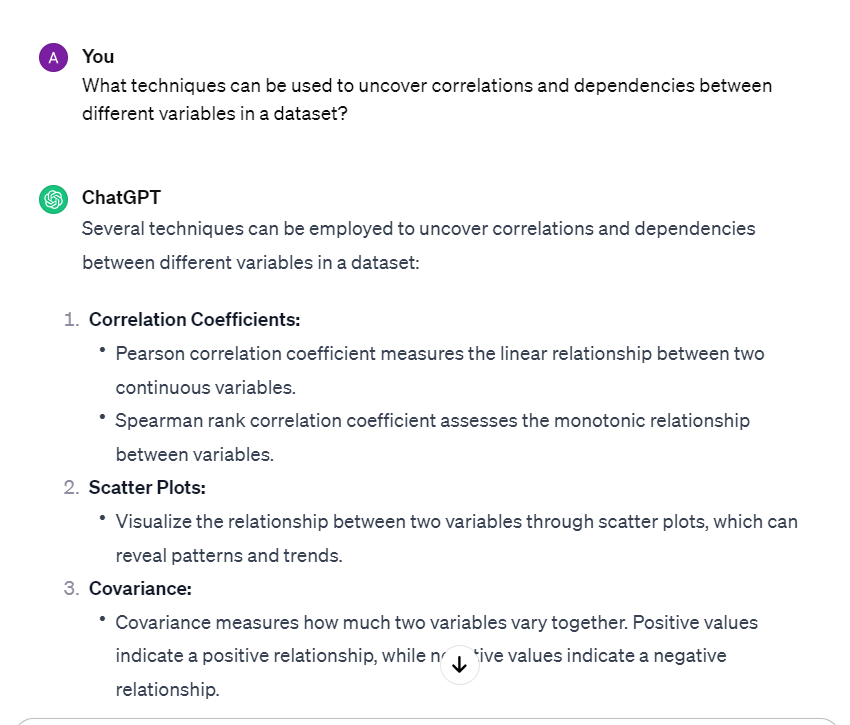
98. The Role of Data Quality
Discuss the importance of data quality in accurate and reliable data analysis, and strategies for ensuring data integrity.
99. Exploring Time Series Analysis
How can time series analysis techniques be used to analyze and forecast trends over time?
100. The Role of Data Governance
Discuss the importance of data governance in ensuring data accuracy, privacy, and security in data analysis.
101. Exploring Text Mining
How can text mining techniques be used to extract insights and patterns from unstructured textual data?
102. The Future of Data Analysis
Discuss emerging trends and technologies in data analysis, and their potential impact on businesses and decision-making.

Get 99+ ChatGPT Prompts for Data Analysis – Complete List Here!
Free Prompts forever – Complete Data Analysis Prompts List
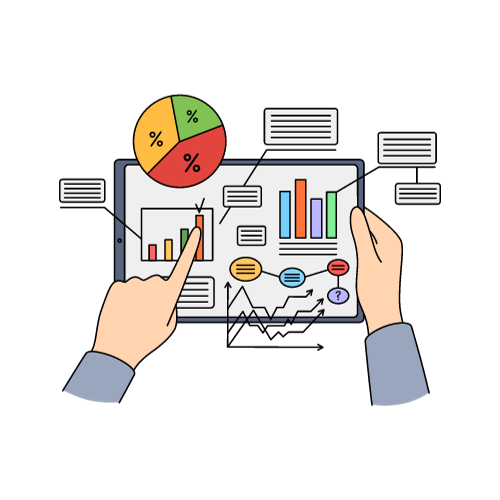
Final Thoughts
In conclusion, ChatGPT Prompts for data analysis serve as invaluable tools for busy professionals navigating the complexities. Simplifying tasks with tailored prompts, these tools save time and energy, providing an efficient solution for crafting optimized Data Analysis. Embrace this tool, and witness your analytical and creative endeavors flourish. Happy analyzing with ChatGPT Prompts!

